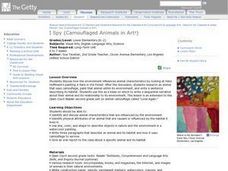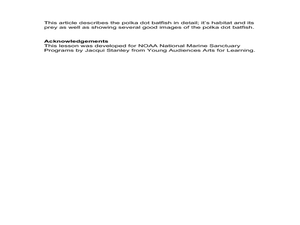Curated OER
How to Hide in the Ocean
Learners observe the advantages of camouflage. They design a well camouflaged fish of their own.
Curated OER
The Amazing Octopus
Students design imaginary animals that are able to blend into their backgrounds. In this biology lesson plan, students will learn the importance of camouflage in protecting animals from predators. Students will select a peer to act as...
Curated OER
Why are Polar Bears White
Students explore camouflage as they study polar bears and their habitat. They study how color can help animals in the wild.
Curated OER
Animals
Young scholars investigate classifying animals. For this animal classification lesson, students choose three animals that use camouflage and list three facts about that animal. Young scholars create a story about the animal, present it...
Curated OER
TIDES
Second graders are taught the concept of camouflage through the game hide and seek. They view photographs of camouflaged animals on the TIDES website. Students create a poster that camouflages a particular animal based on what they have...
Curated OER
I Spy (Camouflaged Animals in Art!)
Make connections about animal characteristics and the animal's environment. In this animal characteristics lesson, students use a piece of art as a springboard for a discussion about animals and camouflage. Students choose an animal that...
Curated OER
Animal Hide and Seek
Students examine how animals use their colors to their advantage. They read the book, "Brown Bear, Brown Bear, What Do You See?," participate in a toothpick camouflaging demonstration, explore the Camouflage Field Book website,...
Curated OER
Graphing Predator/Prey Data
Students use data from the Camouflage Game (played with red and green yarn caterpillars) to create a composite bar graph to display the collected data. They interpret the data and form a conclusion based on the graphs. Teachers may use...
Curated OER
How Organisms Live Successfully in Their Environments
Students compare the climate and organisms found in different environments, then give examples of how plants and animals adapt to their environment. They design an animal who adapts using camouflage to a made-up environment.
Curated OER
Chameleons Are Cool!
Have your learners review what they know about camouflage using this lesson. Learners fill out a graphic organizer listing what they know or have questions about. This could be enhanced with the addition of a writing assignment in which...
Curated OER
Animal Camouflage 1
Second graders work in groups and they are asked to line up on either side of the board. They are explained that on the teachers instruction, one student at a time runs to the marked area and brings back the first worm they see. Students...
Curated OER
The Camouflage Game
Young scholars analyze the numbers of each color of caterpillar collected, and discuss reasons for this. PowerPoint presentations may be made. This lesson requires the teacher to set up a situation prior to teaching. Red and Green...
Curated OER
Caterpillar Camouflage
Students list animals, plant parts, and reasons for caterpillars to camouflage themselves. In this animal and plant adaptations lesson plan, students also play a game where they use colors as camouflage.
Curated OER
Butterfly Camouflage
Fifth graders discuss camouflage and warnings by butterflies as a class. Students design and color their own butterflies that they are to place somewhere in the classroom. Students explain why their butterfly is colored the way that it...
Curated OER
Caterpillar Camouflage
First graders are introduced to the concept of camouflage. Individually, they color a paper caterpillar to match its surroundings to not be attacked by prey. To end the lesson, they participate in a game in which some caterpillars...
Curated OER
Hide and Seek
Pupils examine animals that use camouflage and discuss why they use it. They create drawing of an imaginary animal that uses camouflage to hide in the classroom and identify the adaptations that would allow it to hide effectively.
Curated OER
Adaptation and Mimicry - Biology
Young scholars compare and contrast adaptations involving camouflage, warning coloration, and mimicry. They explain the relationship between adaptation and ability for survival and reproduction. Students define Batesian and Mullerian...
Curated OER
Drawing Fish
Students practice creating art by imitating the camouflage of fish. In this animal characteristic lesson, students identify certain fish and their ability to change colors in order to survive in the wild. Students utilize coloring...
Curated OER
Finding Caterpillars
Learners examine how animals protect themselves from predators and camouflage themselves. They participate in a simulation in which they locate red and green yarn "caterpillars," organize their data, and generate a bar graph using...
Curated OER
Toothpick Worms
Young scholars investigate camouflage. In this science lesson plan, students experience the role of color in camouflage as they complete a hands-on activity.
Curated OER
Trout Markings
Students paint a trout based on the pictures of trout coloration and markings they see in pictures. In this trout lesson plan, students understand that the markings on a trout are native to their habitats and create camouflage.
Curated OER
Natural Selection
Pupils construct a working definition of the word "evolution," and list the key points of Darwin's theory of natural selection. They create paper moths to help them explain the importance of camouflage and how it relates to natural...
Curated OER
Leo's Colorful Story
Motivate your learners with this lesson about the Tiger Swallowtail Butterfly. They listen to a story about the butterfly and then follow directions to color pictures. This is a simple, but effective lesson with all the necessary...
Curated OER
Guess Who?
Getting ready for a lesson on animal adaptations can be a lot of fun. Kindergartners will go on an egg hunt. Once they have collected all the eggs, they will open them up to reveal an image of an animal. Each pupil will act out their...
Other popular searches
- Animal Camouflage
- Butterflies and Camouflage
- Camouflage and Mimicry
- Camouflage and Art
- Biology Camouflage
- Camouflage by Animals
- Camouflage Mimicry
- Camouflage Lessons
- Camouflage in the Ocean
- Powerpoint Animal Camouflage
- Camouflage Moths
- Animal Camouflage Adaptation

























